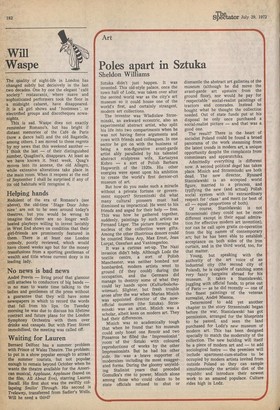Art
Poles apart in Sztuka
Sheldon Williams
Sztuka didn't just happen. It was invented. This old-style palace, once the town hall of Lodz, was taken over after the second world war as the city's art museum so it could house one of the world's first, and certainly strangest, modern art collections.
The inventor was Wladislaw Strzeminski, an awkward eccentric, also an experimental abstract artist, who split his life into two compartments when he was not having fierce arguments and rows with friends and colleagues. In one sector he got on with the business of being a non-figurative avant-garde artist ably paralleled by his talented abstract sculptress wife, Kartazyna Kobro — a sort of Polish Barbara Hepworth of the 1920s, His other energies were spent upon his ambition to create the world's first dernier-cri museum of art.
But how do you make such a miracle without a private fortune or government support? Strzeminski did what many cultural pioneers must had dismissed as impractical. He went to his friends and asged for their help — free. This was how he gathered together, suddenly, paintings by such artists as Fernand Leger. The picture forming the nucleus of the collection were gifts. Among the other illustrious donors could be counted Hans Arp, Max Ernst, Jean Lurgat, Ozenfant and Vantongerloo.
It was a curious set-up. The Nazi invasion didn't help. Although Lodz the textile centre, a sort of Polish Manchester, was neither bombed nor bombarded, modern artists went to ground (if they could) during the occupation, and the Germans did manage to destroy some of what they could lay hands upon (Kulturbolschewismus). Slighter, but fresh trouble arose after the war when Marian Minich was appointed director of the nowofficial museum (the Sztuka). Strzeminski was an artist. Minich was a scholar, albeit keen on modern art. They had their differences.
Minich was so academically tough that when he found that his museum could only boast one Renoir and two Pissarros he filled the ' Impressionist ' room of the Sztuki with coloured reproductions of works by the other Impressionists. But he had his other side. He was a brave supporter of modernism including its most exaggerated forms. During the gloomy unyielding Stalinist years that preceded Gomulka's rise to power, Minich alone among those who could claim to be state officials refused to shut or dismantle the abstract art galleries of the museum (although he did move the avant-garde art upstairs from the ground floor), nor would he pay for ' respectable ' social-realist paintings of tractors and comrades. Instead he bought what he thought the collection needed. Out of state funds put at his disposal he only once purchased a social-realist picture — and that was a good one.
The result? There in the heart of socialist Poland could be found a broad panorama of the work stemming from the latest trends in modern art, a unique opportunity despite the complaints from commissars and apparatchiks.
Admittedly everything is different now. A second political degel has taken place. Minich and Strzeminski are both dead. The new director, Ryszard Stanislawski is an accepted world figure, married to a princess, and typifying the new (and actual) Polish social system with its extraordinary respect for class' and merit (or best of all — equal proportions of both).
Of course, Stanislawski is not Strzeminski (they could not be more different except in their equal admiration for effective modern art invention), nor can he call upon gratis co-operation from the big names of contemporary art; but he has been able to establish , acceptance on both sides of the iron curtain, and in the third world, too, for that matter.
Young, but speaking with the authority of the art voice of an industrial city (the second city of Poland), he is capable of catching some very fancy bargains abroad for his museum. It takes a Stanislawski, juggling with official funds, to prise out of Paris — as he did recently — one of the finest paintings of the veteran surrealist, Andre Masson.
Determined to add yet another chapter to the story Strzeminski began before the war, Stanislawski has got permission, arranged for the blueprints to be passed, and seen the land purchased for Lodz's new museum of modern art. This has been designed specially to match the modernity of the collection. The new building will itself be a piece of modern art and — to add sociological lustre — the premises will include apartment-cum-studios to be occupied by modern artists invited from outside Poland so they can sample simultaneously the artistic diet of the republic and introduce their newest work to an amazed populace. Culture rides high in Lodz.








































 Previous page
Previous page